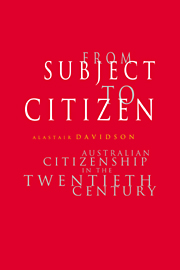Book contents
- Frontmatter
- Contents
- List of Figures
- List of Tables
- Acknowledgments
- Abbreviations
- Introduction
- PART I From Subject to Citizen 1901–1996
- 1 Civis Romanus Sum
- 2 From Subject to Citizen I: to 1948
- 3 Nationality and the Citizen II: 1948–1986
- 4 From Subject to Citizen III: 1983–1996
- Part II Discourses of Exclusion
- Part III The Active Citizen and Beyond
- Conclusion
- Notes
- Select Bibliography
- Index
3 - Nationality and the Citizen II: 1948–1986
Published online by Cambridge University Press: 06 January 2010
- Frontmatter
- Contents
- List of Figures
- List of Tables
- Acknowledgments
- Abbreviations
- Introduction
- PART I From Subject to Citizen 1901–1996
- 1 Civis Romanus Sum
- 2 From Subject to Citizen I: to 1948
- 3 Nationality and the Citizen II: 1948–1986
- 4 From Subject to Citizen III: 1983–1996
- Part II Discourses of Exclusion
- Part III The Active Citizen and Beyond
- Conclusion
- Notes
- Select Bibliography
- Index
Summary
the men are handsome and the women beautiful
Arthur Calwell, ALP Minister for Immigration, 1948In 1948 any alien who wished to become an Australian citizen had to prove first that he or she belonged to the national family. Australian rules thus conformed to those of all nation-states by requiring that all citizens belong to the nation. In Australia the status of national was governed legally by the ius soli, but its practice and the popular understanding was closer to the ius sanguinis than to the position in Great Britain. It has been noted that much later than 1948 some Australian commentators still denned ‘Asian-ness’ by degrees of ‘blood’ and that one-sixteenth Asian ‘blood’ made someone an Asian. This was much less than the one-eighth Jewish ‘blood’ which Nazism declared made someone a Jew. Such a national citizen, once recognised as such by birth or by naturalisation, could engage in acts of citizenship limited by the state to which he belonged. At any given time in Australia those acts were remarkable by the degree to which they were restricted and did not meet fundamental criteria for a democratic citizen as established in contemporary theory and practice, or by ‘best practice’. They did not meet the criteria for the active citizen either with regard to the vote, or the human rights required to make that vote possible. Both these facts were hardly ever addressed, above all because the relative well-being of Australia – that is the outcomes of the socio-political organisation in welfare terms – was exceptionally good when compared on a world scale.
- Type
- Chapter
- Information
- From Subject to CitizenAustralian Citizenship in the Twentieth Century, pp. 84 - 112Publisher: Cambridge University PressPrint publication year: 1997



